What Is Rejection Sensitive Dysphoria?
Demystifying rejection sensitive dysphoria. Discover its causes, coping strategies, and the path to thriving with strength and resilience.
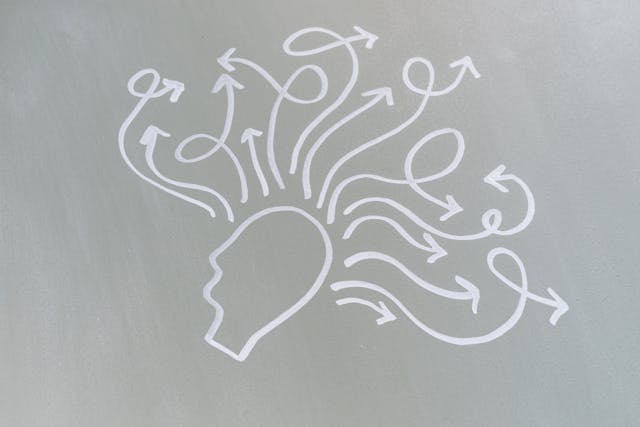

Understanding Rejection Sensitive Dysphoria
Rejection Sensitive Dysphoria (RSD) is a complex and often misunderstood condition that can significantly impact an individual's emotional well-being and relationships. In order to better comprehend RSD and its effects, it is important to delve into its definition, as well as the symptoms and manifestations associated with this condition.
Defining Rejection Sensitive Dysphoria
Rejection Sensitive Dysphoria is an emotional response characterized by an intense and overwhelming fear of rejection, criticism, or disapproval from others. Individuals with RSD may experience an acute sensitivity to perceived or actual rejection, which can trigger a range of emotional and physical responses.
Symptoms and Manifestations
RSD can manifest in various ways, and the symptoms may vary from person to person. Some common symptoms and manifestations of Rejection Sensitive Dysphoria include:
- Emotional hypersensitivity: Individuals with RSD may experience intense emotional responses to situations that may seem trivial or insignificant to others. These emotions can include sadness, anger, anxiety, and a deep sense of shame or embarrassment.
- Fear of rejection: The fear of rejection is a key characteristic of RSD. Individuals may go to great lengths to avoid situations or interactions that they perceive as potentially leading to rejection. This fear can significantly impact their personal and professional relationships.
- Excessive self-criticism: Those with RSD often have a tendency to be overly self-critical. They may constantly seek validation from others and have a heightened sensitivity to any perceived criticism or negative feedback.
- Avoidance and withdrawal: Due to the fear of rejection, individuals with RSD may withdraw from social situations or isolate themselves to avoid potential negative experiences. This can lead to feelings of loneliness and further exacerbate their emotional distress.
- Physical symptoms: RSD can also manifest in physical symptoms such as headaches, stomachaches, muscle tension, and difficulty sleeping. These physical symptoms may be a result of the heightened emotional distress experienced by individuals with RSD.
It is important to note that Rejection Sensitive Dysphoria is not an officially recognized diagnosis in the Diagnostic and Statistical Manual of Mental Disorders (DSM-5), but it is often associated with conditions such as attention deficit hyperactivity disorder (ADHD).
Understanding the defining characteristics, symptoms, and manifestations of Rejection Sensitive Dysphoria is crucial for recognizing and seeking appropriate support for individuals affected by this condition. By increasing awareness and understanding, we can foster a more compassionate and supportive environment for those navigating the challenges of RSD.
Causes and Triggers
Rejection Sensitive Dysphoria (RSD) is a complex condition that can arise from a combination of neurobiological factors and emotional triggers. Understanding these causes and triggers can provide valuable insights into the experience of individuals with RSD.
Neurobiological Factors
Neurobiological factors play a significant role in the development of Rejection Sensitive Dysphoria. Research suggests that individuals with RSD may have an imbalance of certain neurotransmitters, such as serotonin and norepinephrine, which are involved in regulating emotions and mood.
Moreover, individuals with RSD may have heightened emotional sensitivity due to differences in the way their brains process and respond to social cues and emotional stimuli. These neurobiological differences can contribute to increased emotional reactivity, making individuals with RSD more susceptible to experiencing intense emotional responses in situations involving perceived rejection or criticism.
Emotional Triggers
Emotional triggers are events or situations that can elicit a strong emotional response in individuals with Rejection Sensitive Dysphoria. These triggers can vary from person to person, but commonly involve situations that involve rejection, criticism, or the fear of disappointing others.
Examples of emotional triggers for individuals with RSD may include:
- Receiving constructive feedback or criticism
- Experiencing rejection or exclusion from social groups
- Fear of failure or making mistakes
- Perceived disapproval or disappointment from loved ones or authority figures
It's important to note that emotional triggers can differ in intensity and frequency for each individual with RSD. What may trigger one person's RSD symptoms may not affect another person in the same way. Understanding these triggers can help individuals with RSD and their support systems develop strategies to effectively manage the emotional responses associated with them.
By recognizing and addressing both the neurobiological factors and emotional triggers associated with Rejection Sensitive Dysphoria, individuals affected by this condition can gain a better understanding of their experiences and work towards developing coping mechanisms that promote emotional well-being.
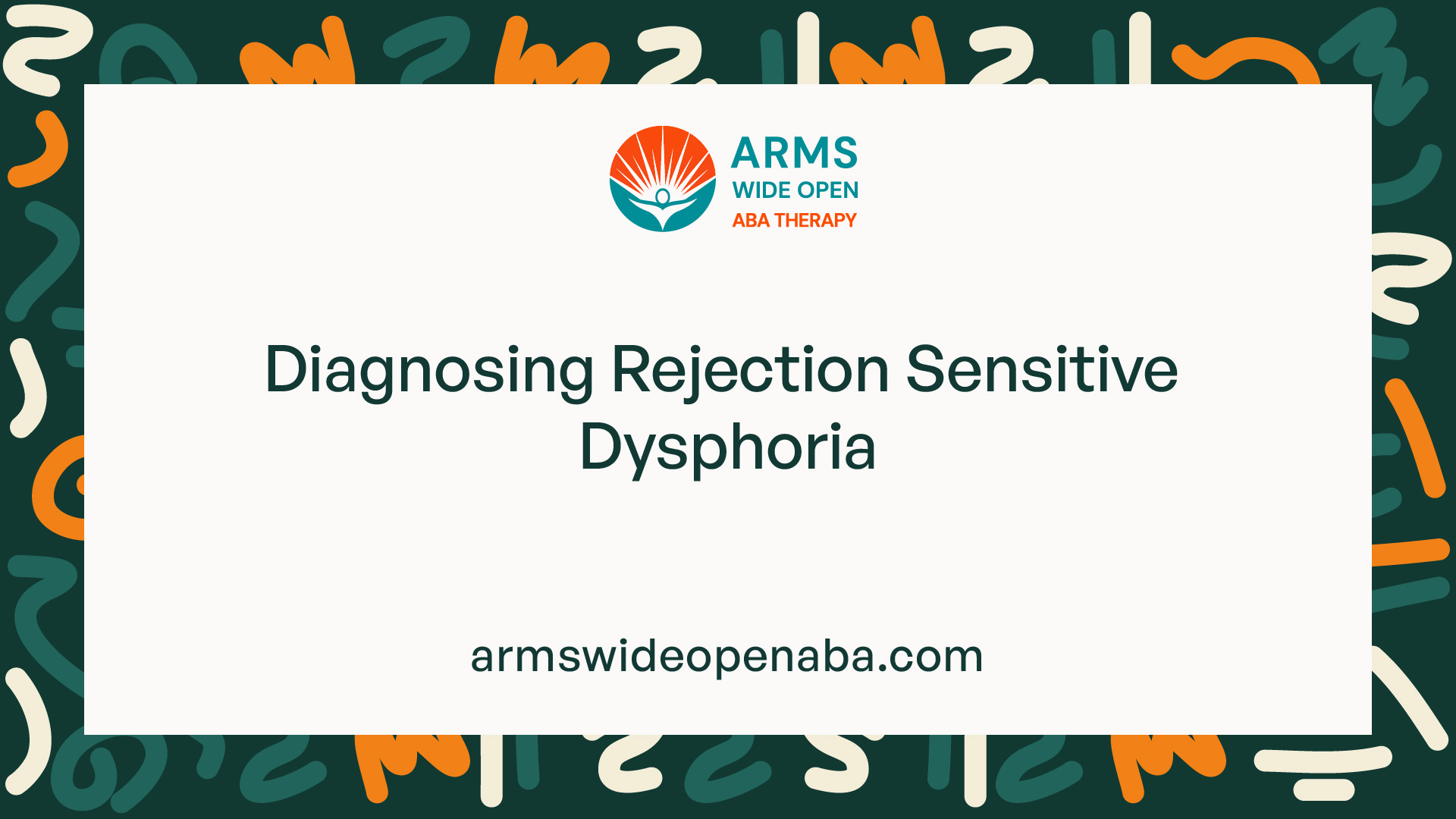
Diagnosing Rejection Sensitive Dysphoria
When it comes to diagnosing rejection sensitive dysphoria (RSD), a comprehensive assessment and evaluation are essential to determine if an individual is experiencing this condition. Additionally, it is crucial to differentiate RSD from other similar conditions through a process known as differential diagnosis.
Assessment and Evaluation
To diagnose rejection sensitive dysphoria, mental health professionals typically rely on a combination of methods, including:
- Clinical Interviews: A thorough interview is conducted to gather information about the individual's symptoms, emotional experiences, and behavioral patterns. This helps the clinician understand the extent and impact of RSD on the person's daily life.
- Self-Report Measures: Standardized questionnaires and scales may be used to assess the severity of RSD symptoms. These measures provide quantitative data that aids in the diagnostic process.
- Medical and Psychiatric History: The clinician may inquire about the individual's medical history, including any previous mental health diagnoses, medications, or treatments. This information helps rule out other potential causes for the symptoms.
- Observation and Clinical Judgment: The clinician observes the person's behavior, emotional reactions, and social interactions during the evaluation process. This helps to assess the presence and impact of RSD symptoms in various contexts.
Differential Diagnosis
Differential diagnosis involves distinguishing rejection sensitive dysphoria from other conditions that may share similar symptoms. Some conditions that may need to be ruled out during the diagnostic process include:
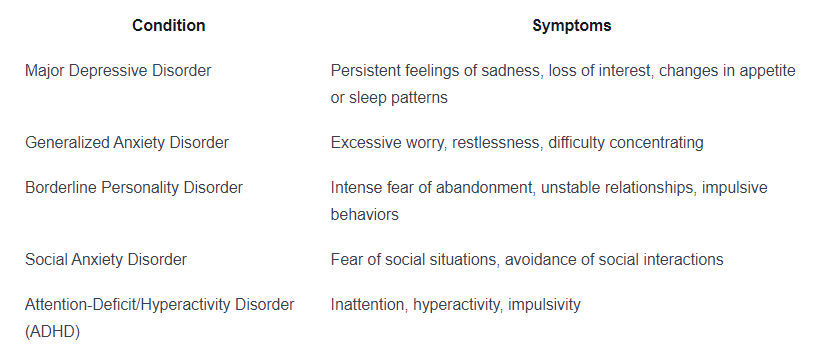
It is important for the clinician to carefully evaluate the individual's symptoms, considering their duration, intensity, and impact on functioning. By differentiating rejection sensitive dysphoria from similar conditions, a more accurate diagnosis can be made, leading to appropriate treatment and support.
If you suspect that you or someone you know may be experiencing rejection sensitive dysphoria, it is recommended to consult with a qualified mental health professional for a comprehensive evaluation and diagnosis.
Coping Strategies
Dealing with rejection sensitive dysphoria can be challenging, but there are strategies that can help individuals navigate their emotions and cope with the symptoms. Two key coping strategies for managing rejection sensitive dysphoria are self-awareness and mindfulness, as well as cognitive behavioral techniques.
Self-Awareness and Mindfulness
Developing self-awareness is an essential aspect of managing rejection sensitive dysphoria. By becoming more attuned to one's emotions and thought patterns, individuals can better understand their triggers and reactions. Practicing mindfulness techniques, such as meditation or deep breathing exercises, can also help individuals stay present and grounded in the face of perceived rejection.
Self-awareness and mindfulness can be cultivated through various practices, including journaling, therapy, and self-reflection. By identifying the specific instances or situations that trigger intense emotional reactions, individuals can begin to develop strategies for coping and building resilience.
Cognitive Behavioral Techniques
Cognitive behavioral techniques are effective tools for managing the symptoms of rejection sensitive dysphoria. These techniques focus on identifying and challenging negative thought patterns and replacing them with more rational and balanced thinking. By reframing negative thoughts, individuals can reduce emotional distress and improve their overall well-being.
One common cognitive behavioral technique used in managing rejection sensitivity is cognitive restructuring. This involves identifying and challenging irrational beliefs and replacing them with more realistic and positive thoughts. By examining the evidence for and against these beliefs, individuals can gain a more accurate perspective on their experiences and reduce the emotional impact of perceived rejection.
Another technique is behavioral activation, which involves engaging in activities that bring a sense of pleasure or accomplishment. By focusing on positive experiences and building self-esteem, individuals can counteract the negative emotions associated with rejection sensitivity.
It's important to note that coping strategies may vary for each individual, and it may take time to find the techniques that work best. Seeking guidance from a mental health professional can provide personalized strategies and support in managing rejection sensitive dysphoria.
By incorporating self-awareness and mindfulness practices, as well as cognitive behavioral techniques, individuals with rejection sensitive dysphoria can develop effective coping strategies to navigate their emotions and improve their overall well-being.
Seeking Support
Rejection Sensitive Dysphoria (RSD) can significantly impact an individual's emotional well-being and daily functioning. Seeking support from professionals and connecting with others who understand can be instrumental in managing RSD. Here are two key avenues for seeking support:
Therapy and Counseling Options
Therapy and counseling can provide valuable support and guidance for individuals with Rejection Sensitive Dysphoria. Mental health professionals, such as psychologists or psychiatrists, can help individuals understand and manage their symptoms effectively. They may utilize various therapeutic approaches, including cognitive-behavioral therapy (CBT), dialectical behavior therapy (DBT), or acceptance and commitment therapy (ACT).
During therapy sessions, individuals can explore the underlying causes and triggers of their RSD, develop coping strategies, and improve emotional regulation skills. Therapists can also provide a safe and non-judgmental space for individuals to express their emotions and concerns.
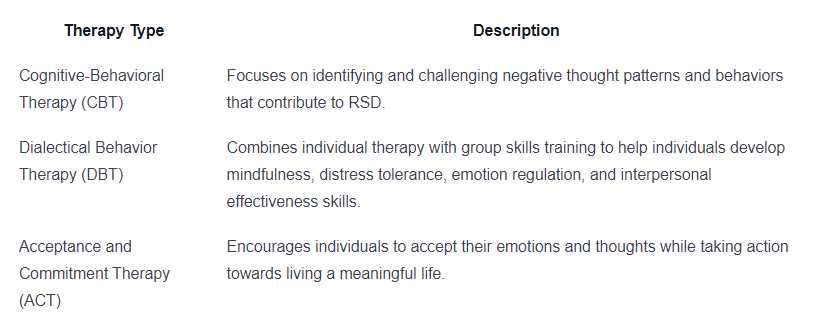
Support Groups and Communities
Connecting with others who share similar experiences can be immensely beneficial for individuals with Rejection Sensitive Dysphoria. Support groups and communities provide a sense of belonging, validation, and understanding. They create a space where individuals can share their challenges, learn from others, and gain valuable insights and coping strategies.
Support groups can be in-person or online, allowing individuals to connect regardless of their location. These groups often have facilitated discussions or structured activities that promote support and growth. Some communities may be specific to RSD, while others may focus on broader mental health topics or specific conditions such as ADHD.
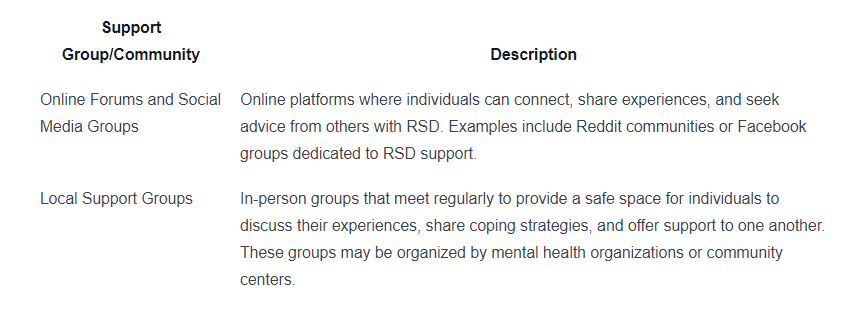
Seeking support through therapy and counseling, as well as joining support groups and communities, can empower individuals with Rejection Sensitive Dysphoria to navigate their challenges more effectively. It is important to find the right support system that resonates with individual needs and preferences. Remember, reaching out for support is a sign of strength and a step towards better emotional well-being.

Thriving with Rejection Sensitive Dysphoria
Living with rejection sensitive dysphoria (RSD) can be challenging, but it is possible to not only cope with it but also thrive. By embracing sensitivity as a strength and building resilience and self-compassion, individuals with RSD can lead fulfilling lives.
Embracing Sensitivity as Strength
One way to thrive with rejection sensitive dysphoria is to reframe sensitivity as a strength rather than a weakness. Sensitivity allows individuals to deeply empathize with others, appreciate beauty in the world, and connect on a profound level. By acknowledging and embracing these qualities, individuals with RSD can develop a sense of self-acceptance and pride in their unique perspective.
It's important to nurture self-awareness and recognize the value of your sensitivity. Engaging in activities that align with your passions and strengths can boost self-esteem and provide a sense of purpose. Surrounding yourself with a supportive network of friends, family, or support groups who understand and appreciate your sensitivity can also contribute to a positive mindset.
Building Resilience and Self-Compassion
Building resilience is crucial for individuals with RSD to thrive. Resilience helps to bounce back from setbacks and navigate the challenges that sensitivity may bring. Here are some strategies that can help:
- Self-compassion: Practice self-compassion by treating yourself with kindness and understanding. Be gentle with yourself when facing rejection or criticism, and remind yourself that everyone experiences setbacks.
- Mindfulness: Engaging in mindfulness practices, such as meditation or deep breathing exercises, can help manage intense emotions and enhance emotional regulation. Mindfulness allows you to observe your thoughts and feelings without judgment, reducing reactivity to rejection triggers.
- Cognitive reframing: Challenge negative thoughts and beliefs that arise from rejection or perceived criticism. Replace them with more positive and realistic self-talk. This can help in developing a more resilient mindset.
- Healthy coping mechanisms: Engage in activities that promote self-care and stress relief, such as exercise, journaling, or pursuing hobbies. These activities can improve overall well-being and provide a healthy outlet for emotions.
By focusing on self-compassion, mindfulness, cognitive reframing, and healthy coping mechanisms, individuals with RSD can build resilience and develop strategies to navigate the challenges associated with rejection sensitivity.
Thriving with rejection sensitive dysphoria is possible by embracing sensitivity as a strength and cultivating resilience and self-compassion. By adopting these approaches, individuals with RSD can lead fulfilling lives while managing the impact of rejection and criticism. Remember, seeking support from therapists, counselors, or support groups can also provide valuable guidance and encouragement along the way.
Sources
https://my.clevelandclinic.org/health/diseases/24099-rejection-sensitive-dysphoria-rsd
https://www.webmd.com/add-adhd/rejection-sensitive-dysphoria
https://www.healthline.com/health/mental-health/rejection-sensitive-dysphoria
Similar articles
We’re here to help you

Our team is here to assist you in this process. Contact us for any assistance.
it’s easy to apply
We Accept Most Insurances
Our in-network insurance partnerships make ABA therapy more accessible to families throughout our service areas.







Our Insurance Process
We'll request your insurance details to help us verify your plan's coverage for ABA therapy. Once we've received this information, we'll walk you through your benefits, including copayments, deductibles and out-of-pocket maximums, so you know what to expect in advance.
Our team will then handle the preauthorization and all the necessary paperwork.
.svg)





















.jpeg)


































.jpeg)




.jpeg)







.jpeg)











.jpeg)
















